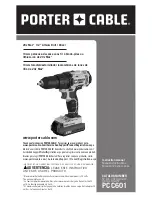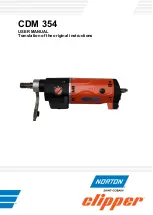
22
English
3. Always apply pressure in a straight line with the bit. Use enough
pressure to keep drill biting, but do not push hard enough to stall
the motor or deflect the bit.
4. Hold drill firmly to control the twisting action of the drill. Use side
handle.
CAUTION:
Drill may stall if overloaded causing a sudden twist.
Always expect the stall. Grip the drill firmly to control the twisting
action and avoid injury.
5.
IF DRILL STALLS
, it is usually because it is being overloaded or
improperly used.
RELEASE TRIGGER IMMEDIATELY,
remove
drill bit from work, and determine cause of stalling.
DO NOT
CLICK TRIGGER OFF AND ON IN AN ATTEMPT TO START
A STALLED DRILL — THIS CAN DAMAGE THE DRILL.
6. To minimize stalling on breaking through the material, reduce
pressure on drill and ease the bit through the last fractional part
of the hole.
7. Keep the motor running when pulling the bit back out of a drilled
hole. This will help prevent jamming.
DRILLING IN WOOD
Holes in wood can be made with the same twist drills used for metal.
These bits may overheat unless pulled out frequently to clear chips
from the flutes. For larger holes, use spade bits, power auger bits, or
hole saws. Work that is likely to splinter should be backed up with a
block of wood.
DRILLING IN METALS
Use a cutting lubricant when drilling metals. The exceptions are cast
iron and brass which should be drilled dry. The cutting lubricants that
work best are sulphurised cutting oil or lard oil; bacon grease will also
serve the purpose.
DRILLING IN MASONRY
Use carbide tipped masonry bits at low speeds. Keep even force
on the drill but not so much that you crack the brittle materials. A
smooth, even flow of dust indicates the proper drilling rate.
MAINTENANCE
WARNING: To reduce the risk of injury, turn unit off and
disconnect tool from power source before installing and
removing accessories, before making any adjustments or
removing/installing attachments or accessories.
An accidental
start-up can cause injury.
Your D
E
WALT power tool has been designed to operate over a
long period of time with a minimum of maintenance. Continuous
satisfactory operation depends upon proper tool care and regular
cleaning.
Lubrication
All bearings used are factory lubricated to last the life of the tool.
All needle bearings used receive their lubrication from the grease in
the gear case. Clean and relubricate gear case yearly or whenever
servicing requires the gear case to be removed. Use type and quantity
of grease shown on Parts Bulletin packed with your tool.
Gear case is removed by removing the four screws from the front
of the tool. If the chuck is too large to permit removal of the two top
screws, see instructions for chuck removal.
Motor Brushes
This D
E
Walt tool uses an advanced brush system which auto matically
stops the tool when the brushes wear out. This prevents seri
ous
damage to the motor.
Cleaning
WARNING:
Blow dirt and dust out of the main housing with dry air
as often as dirt is seen collecting in and around the air vents. Wear
approved eye protection and approved dust mask when performing
this procedure.
WARNING:
Never use solvents or other harsh chemicals for





































